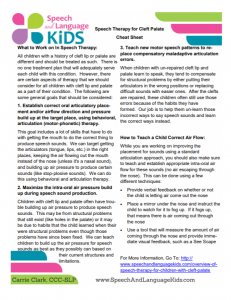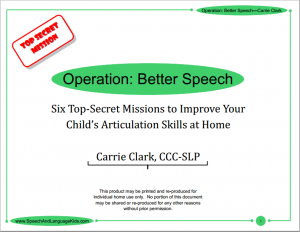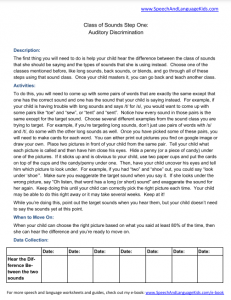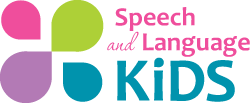What is a Cleft Lip or Palate?
Some children are born with holes or clefts in their lip or palate (roof of the mouth). This can cause severe difficulties with speech as well as with eating. These structural problems are often fixed with surgery as early as possible but even with surgery, speech therapy is still often needed to help the child produce speech sounds clearly. Here is an overview of what speech therapy looks like for a child with a repaired or unrepaired cleft lip or palate.
How do you do Speech Therapy for a Child with Cleft Lip/Palate?
1. Ensure Medical Management and Follow-Up
The first thing you should do when beginning to work with a child who has a repaired or unrepaired cleft lip or palate is to make sure that the child is being treated and followed by a cleft palate team. Cleft lips and palates are not the type of problem you can just fix up once and forget about. As the child grows and develops, new problems can arise so each child who has a history of cleft lip or palate should be getting regular checkups from a certified cleft palate care team. Here’s a link that will help you find the closest team to you:
http://www.cleftline.org/parents-individuals/team-care/
2. Check Hearing Frequently
The next thing you will need to do with a child with a history of cleft lip or palate is to check his/her hearing frequently. Children with these conditions are more prone to conductive hearing loss later in life so their hearing should be checked regularly throughout childhood. Make sure hearing is checked at regular intervals but also perform additional checks if you feel that something is wrong. The quicker we can catch hearing problems, the less of a problem it will become.
3. Treat Speech/Language Delays as Needed
All children with a history of cleft lip or palate are different and should be treated as such. There is no one treatment plan that will adequately serve each child with this condition. However, there are certain aspects of therapy that we should consider for all children with cleft lip and palate as a part of their condition. The following are some general goals that should be considered:
- Establish correct oral articulatory placement and/or airflow direction and pressure build up at the target place, using behavioral, articulation (motor-phonetic) therapy.
This goal includes a lot of skills that have to do with getting the mouth to do the correct thing to produce speech sounds. We can target getting the articulators (tongue, lips, etc.) in the right places, keeping the air flowing out the mouth instead of the nose (unless it’s a nasal sound), and building up air pressure to produce certain sounds (like stop-plosive sounds). We can do this using behavioral and articulation therapy.
- Maximize the intra-oral air pressure build up during speech sound production.
Children with cleft lip and palate often have trouble building up air pressure to produce speech sounds. This may be from structural problems that still exist (like holes in the palate) or it may be due to habits that the child learned when there were structural problems even though those problems have since been fixed. We can teach children to build up the air pressure for speech sounds as best as they possibly can based on their current structures and limitations.
- Teach new motor speech patterns to replace compensatory maladaptive articulation errors.
When children with un-repaired cleft lip and palate learn to speak, they tend to compensate for structural problems by either putting their articulators in the wrong positions or replacing difficult sounds with easier ones. After the clefts are repaired, these children often still use those errors because of the habits they have formed. Our job is to help them un-learn those incorrect ways to say speech sounds and learn the correct ways instead.
How to Fix Speech Sound Errors in Children with Cleft Lip/Palate
Once we’re ready to dive into doing therapy with these kiddos, we first need to identify limitations of the child’s structures. Which speech sounds is the child physically able to produce? This will depend not only on the structures present (are there holes in the palate?) but also the child’s ability to move those structures. For example, if the child has an adequate soft palate but is unable to raise it up to close off the nasal cavity, we must consider that as a limitation for oral speech sounds.
Information about the child’s oral structures and function should come from the child’s cleft palate team. They will be aware of all problems that the child has with structures or function and will be able to advise on appropriate appliances or prosthetics to assist the child, if needed. Speak with the child’s cleft palate team about what sounds the child is physically able to produce and which ones will be impossible for the time being.
If the Child IS Structurally Able to Produce a Sound:
After speaking with the child’s cleft palate team, you should have a nice list of the sounds that the child is physically able to produce. Check that list against the sounds that the child is currently producing incorrectly. If you see a sound (or many sounds) that the child should be able to produce correctly but is not, you can target those in therapy.
In therapy we will work on these sounds by correcting the child’s placement and production using a typical articulation therapy. This means, we’ll show the child where to put his articulators and how to move them to produce the sound correctly.
If you need more resources on how to do the articulation approach to therapy, check out my All-In-One Articulation Program and Materials Kit!
While you are working on improving the placement for these sounds, you should also make sure to teach and establish appropriate intra-oral air flow for these sounds (no air escaping through the nose). This can be done using a few different techniques:
- Provide verbal feedback on whether or not the child is letting air come out the nose.
- Place a mirror under the nose and instruct the child to watch for it to fog up. If it fogs up, that means there is air coming out through the nose.
- Use a tool that will measure the amount of air coming through the nose and provide immediate visual feedback, such as a See Scape.
If the Child IS NOT Structurally Able to Produce a Sound:
If the child is not physically able to produce a certain sound, you can work on finding the closest approximation for that sound that the child is able to do. What can the child do with his mouth that will make it sound the most like the correct sound? This will take some trial and error of asking the child to do different things with his mouth and articulators and listening to hear which one sounds the most like the correct sound.
Once you find the child’s closest production, teach the child that placement and work on correct air flow with that sound. Get it as close as possible to the original sound so that others will have a better chance of understanding the child.
If the child is about to get surgery to correct the physical limitations that prevent the child from producing the sound, you can teach correct placement for that sound ahead of time to get a head start on therapy once the surgery is completed.
Considering AAC for Severe Cases
Some children with cleft lip and palate will have a difficult time communicating with those around them due to the limitations of their oral structures and functions. If you are working with a child who has highly unintelligible speech or is becoming frustrated by the fact that others can’t understand him, you can always look for alternative or back-up ways for that child to communicate when his speech isn’t quite enough.
This doesn’t mean that we are giving up on speech all together, we’re just putting a back-up plan in place in case the child needs it. Here are some ideas of the types of alternative communication that may be used to assist the child:
- Teaching the child to use gestures, body language, and “acting it out” to get their message across
- Teaching the child some sign language to help him communicate
- Giving the child a board or book full of pictures that he can point to
- Giving the child a device that will allow him to push a button that will speak the message he’s trying to get across
Non-Speech Oral Motor Exercises:
For the clinician treating individuals with resonance disorders, non-speech oral motor tasks (e.g., blowing, whistling, sucking, horn therapy, palatal massage, etc.) are typically not effective in treating any speech errors. This information comes from the American Speech-Language Hearing Association and is based on reviews of the current literature and research of what is effective for children with speech and language disorders.
Free Therapy Materials for Working with Clients with Cleft Lip/Palate:
Check out the freebies that we have inside our Free Therapy Material Library!

Cleft Lip/Palate Therapy Cheat Sheet

Operation Better Speech:
Home Speech Sound Resources

Guide for Teaching a Whole Class of Sounds (Phonology Approach)
Carrie’s Best Tools to Simplify your Life:
You have a lot on your plate. Let me help with that!
I’ve put together my best resources here. Whether you’re streamlining your job as a speech-language professional, helping your child with his communication challenges, or trying to meet the diverse needs of your students, I’ve got you covered.
Choose the resource that you need most right now:







Leave A Comment